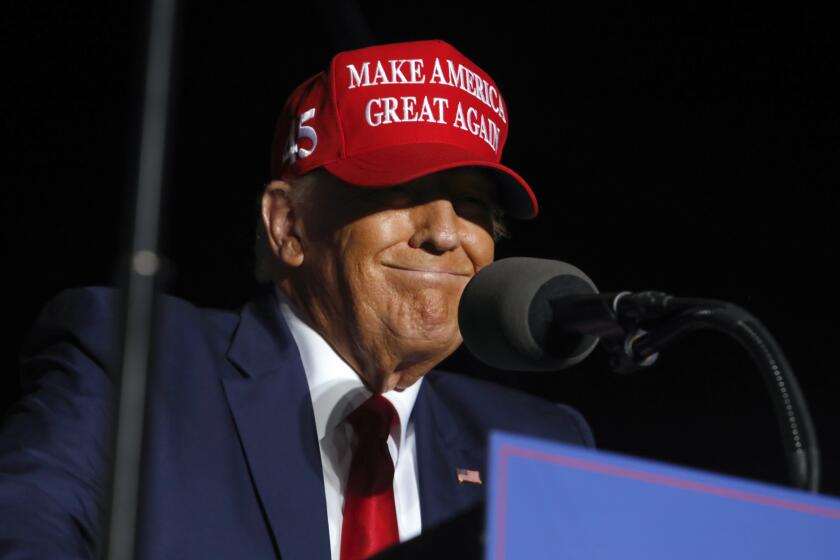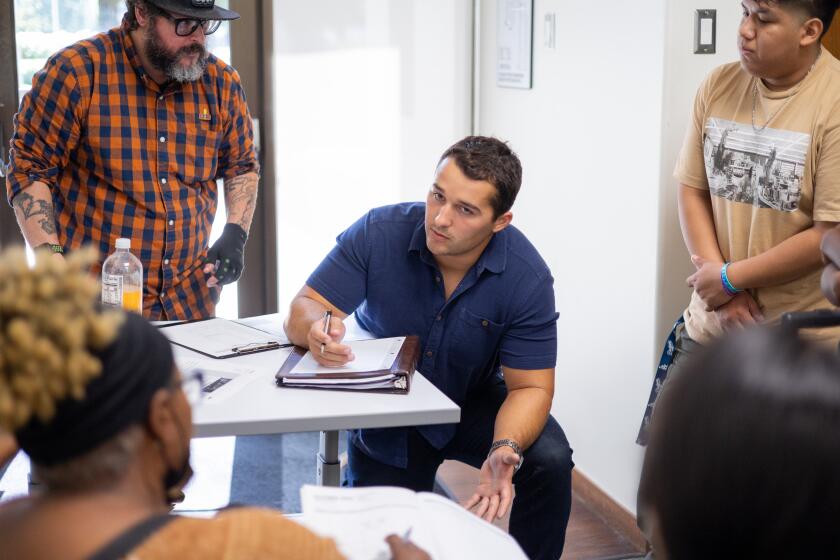Op-Ed: The neglect of younger voters is a lost opportunity for political parties

- Share via
The day after the midterm elections last week, President Biden held a news conference where he praised the “young people of this nation” for showing up at the polls.
With Democrats having dodged the highly anticipated “red wave” of defeat, the president’s comments — and others subsequently being made by political pundits — imply turnout by youth made a difference for the party. Sixty-two percent of young voters supported Democratic House candidates, according to the Center for Information and Research on Civic Learning and Engagement at Tufts University.
Indeed, according to this same report, turnout among voters ages 18-29 was the second-highest for a midterm election in the last 30 years.
Youth turnout was also notably higher in several electorally competitive states, including key battlegrounds like Georgia, Nevada and Pennsylvania. However, the extent to which the youth vote affected results in these states and across the nation will not be known with certainty until after January, when results will have been certified and researchers have analyzed the official election voter files.
So, can Democrats really take credit for turning out the youth vote during last week’s midterms? Or did the Republican Party drive this group to the polls?
It was likely neither.
That’s because both parties, along with their candidates and campaigns, typically don’t spend much time or energy conducting significant outreach to young voters, nor do they consider them key to victories. Rather, it’s older voters who get the overwhelming bulk of campaign resources and attention — even in this election.
In the event of a Republican blowout, I was going to write that MAGA was who we are. But the battle for the soul of the country is not yet over.
This lopsided attention to older voters has significant consequences and is a large part of why turnout disparities by age have become entrenched in our electoral system. Even though youth turnout was higher this midterm, it was still low compared with overall voter turnout — only 27% of those age 18-29 cast ballots.
Generally, candidates and political strategists do not have a vested interest in seeing all possible voters turn up at the polls, even those of the same party. Instead, campaigns almost universally rely on “likely voter” models to determine which voters have the greatest chance of turning out and therefore are a strategic investment for candidates’ campaign budgets.
Because young people historically turn out to vote in much lower percentages than older voters — typically 20 to 40 percentage points lower than the 65-plus age group, depending on the election — campaigns decide that it’s not in their best interests to target resources toward youth. It’s also why the issues of interest cited most frequently by young people, such as climate change, gun violence and reproductive rights, are often overlooked by campaigns and candidates in favor of issues important to older voters such as Medicare, prescription drugs and Social Security.
For these reasons, it’s quite rational why many younger voters don’t feel compelled to participate in the electoral process. Our system largely ignores them and the issues they care about, discouraging involvement. And so the vicious cycle repeats, one election to the next.
Largely ignoring the youth vote is a lost opportunity for Democrats and Republicans. Engaging more young voters is a strategy that would lift both parties. That means not simply maintaining current youth turnout rates but increasing those numbers and making the overall youth vote more representative and proportionate to its share of the population.
Our electoral system needs to pay more than just lip service to youth voters and make more sincere efforts to energize, engage and encourage them to vote.
Research has shown that if you earnestly court young people and make the case for why voting matters, they show up. Young people care about issues and are civically active in many ways but often just don’t see how the act of voting itself can cause meaningful change.
Campaigns and candidates rarely make the connection between the act of voting and the issues that young people care about. But the case for voting has to be made.
In California, where competitive congressional races could determine control of Congress, young voters have the power to alter an election’s outcome.
We need to do a much better job of introducing young people to the civic and electoral process. Young people who have had high-quality civics educational experiences are more likely to vote when eligible, form political opinions, understand campaign issues and know basic facts about how our electoral system works. High school students who learn how voting can affect their lives, how to register and how to actually vote are more likely to cast ballots when they turn 18 than those who don’t.
But most youth get an abysmal civics education — and when they turn 18 society expects them to magically know how to vote and feel that it matters, that it will make a difference on the issues they care about. It is absurd to blame them for not voting and say it’s because they are apathetic or that there is something wrong with their generation.
Voting is habit-forming. Young people who vote at age 18 are more likely to keep voting as they get older. Engaging young voters means creating future generations who will show up at the ballot box, growing our democracy.
For years now, we’ve been involved in this blame game. But the truth is that our electoral system, political parties and campaigns, as well as our educational system, have done a poor job of helping younger voters believe in the importance of the voting process. Instead of blaming our youth, let’s start engaging them in sincere and effective ways. Any politician’s praise is empty without real and significant resources directed toward youth. The future of our democracy depends on it.
Mindy Romero is the director of the Center for Inclusive Democracy at the USC Price School of Public Policy.
More to Read
A cure for the common opinion
Get thought-provoking perspectives with our weekly newsletter.
You may occasionally receive promotional content from the Los Angeles Times.












